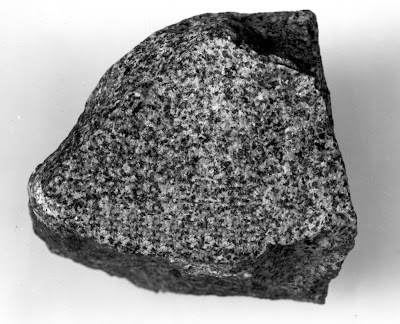Igneous rocks (from the Greek word for fire) form from when hot, molten rock (magma) crystallizes and solidifies. The melt originates deep within the Earth near active plate boundaries or hot spots, then rises toward the surface. Igneous rocks are divided into two groups, intrusive or extrusive, depending upon where the molten rock solidifies.
Extrusive , or volcanic, igneous rock is produced when magma exits and cools outside of, or very near the Earth's surface. These are the rocks that form at erupting volcanoes and oozing fissures. The magma, called lava when molten rock erupts on the surface, cools and solidifies almost instantly when it is exposed to the relatively cool temperature of the atmosphere.
Quick cooling means that mineral crystals don't have much time to grow, so these rocks have a very fine-grained or even glassy texture. Hot gas bubbles are often trapped in the quenched lava, forming a bubbly, vesicular texture. Pumice, obsidian, and basalt are all extrusive igneous rocks.
Intrusive, or plutonic igneous rock forms when magma is trapped deep inside the Earth. Great globs of molten rock rise toward the surface. Some of the magma may feed volcanoes on the Earth's surface, but most remains trapped below, where it cools very slowly over many thousands or millions of years until it solidifies.
 Igneous Rock Un-retouched image | Yellowstone National Park, Wyoming. Intrusive igneous rock (diorite) from Electric Peak stock in the Gallatin Range. The rock is composed chiefly of light-colored quartz and feldspar and dark-colored iron and magnesium silicate minerals. 1970. Figure 20, U.S. Geological Survey Bulletin 1347. Terms of Use, Copyright, and Publishing Information |
All photographs within this collection are public domain; therefore, signed releases, permissions, and payment for use or reproduction are not required.
Private authors or users outside the USGS may not copyright any part of this collection of photographs.
All photographs are provided with the understanding that such material may not be used to show, by implication or otherwise, that the U.S. Department of the Interior or the U.S. Geological Survey endorses any product or service.
For any use made of a photograph, credit should be given to the individual photographer and the U.S. Geological Survey.
U.S. Geological Survey For questions regarding original photographs or usage, please contact Photo Collection at (303) 236-1010 or den_lib@usgs.gov.













No comments:
Post a Comment